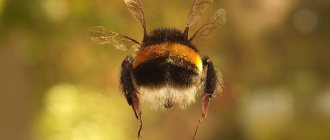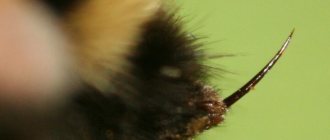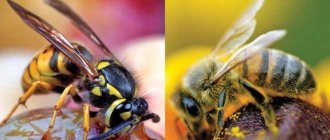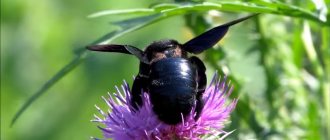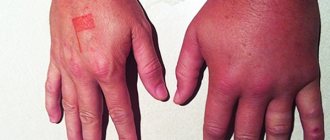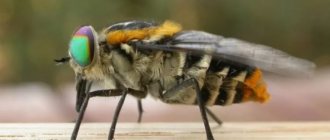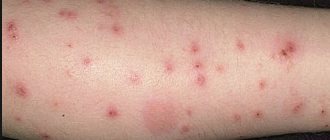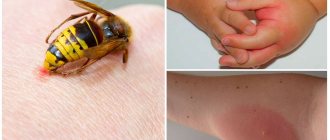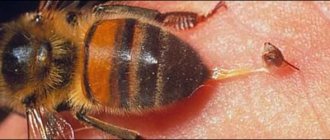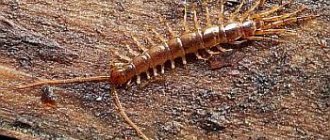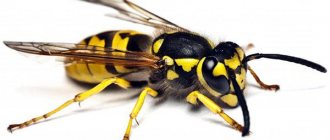Features of the black bee
Xylocopa is a bee that grows much larger than a honey bee.
It has a black body with blue wings. The insect settles in the wood of dry trees. If measures are not taken immediately, then within a year there will be a whole colony of them. In addition to old trees, the black bee can settle in the wooden elements of buildings, where it begins to make a tunnel, gnawing along the outer wall, at a distance of two or three centimeters from the edge. In this case, the tunnel can be very long, at least thirty centimeters. Despite the fact that the insect is a bee, it does not produce wax or honey, but it greatly damages wooden structures. These bees are also called carpenter bees; they are solitary insects, the same as mason bees. This species has individuals: male and female. While honeybees have: a worker bee, a drone and a queen. Despite the fact that both types of insects are completely different and do not resemble each other in any way, there is one common property between them - the male does not have a stinger, and therefore does not sting.
Interesting. Considering the characteristics of carpenters, it should be noted that these individuals are not aggressive.
Male black bees do not have a sting and do not sting the enemy; in appearance they are completely indistinguishable from females. Depending on the species (there are more than five hundred of them in the genus Xylocopa), the body can be up to three centimeters long. The insect's abdomen has an unusual black color. In addition, there is absolutely no gun on him.
There are some species that do have hairs that are light brown, green, or yellow-green. For his home, the carpenter chooses soft wood, in which he makes only one entrance, which turns into a tunnel. During the construction of the tunnel, insects do not eat fiber, they simply saw the wood; you can find the entrance by microscopic shavings and sawdust.
Black bee
Important! The black bee does not settle in such wood species as birch, oak, beech and ash. In addition, if a tree grows and develops, then a bee will not settle in it
In this case, she chooses wood for building materials.
Characteristics
The bumblebee is a large insect whose diet includes pollen and nectar. Their competitive advantage over bees lies in their warm-blooded body. This feature was formed due to the fact that the pectoral muscle contracts at a rapid pace, dispersing blood. Therefore, the bumblebee is not afraid of frost, that is, it leads a cold-resistant lifestyle.
Scientific classification:
- domain – eukaryotes;
- kingdom - animals;
- phylum – arthropods;
- class - insects;
- order - Hymenoptera;
- family - real bees;
- genus – bumblebees (Bombus).
At first glance, a bumblebee looks like a bee, but the adults still do not resemble each other in everything. The main difference is the thickness of the cover. The body of a bee is covered with sparse hairs, while bumblebees have a shaggy coat.
Characteristics:
- dense, thick body - wider than that of a bee or wasp;
- a smooth sting without serrations in females and working specimens;
- body length (size) – up to 3 cm;
- weight – worker up to 600 mg, uterus up to 1 g;
- color – black and yellow stripes, sometimes there are orange-red rings or completely black color;
- length of the proboscis is 7–20 mm (the task is to penetrate the flower for nectar).
Bumblebees are frost-resistant insects. The appearance of this feature is explained by the rapid contraction of muscles and the presence of thick integument. The hairs warm the body, so adults are not afraid to fly out in cold weather, early in the morning and late in the evening. To cool down in the heat, the bumblebee secretes a drop of saliva - this method helps facilitate flight due to the evaporation of liquid and cooling.
What behavior does the black bumblebee have and how does it reproduce?
The black bumblebee differs from other members of the family in its large body size (27 mm). All individuals are assigned to the genus Xylocopa. The insect has a completely black color with the effect of purple reflections. At first glance, it may seem to ordinary people that there is a fly in front of them. Blue bumblebees live solitary lives, never creating large working families under the leadership of an authoritative queen.
- The bee has a fairly calm disposition and will not attack a person passing by. However, the bite force of the black (blue) bumblebee is several times higher than that of an ordinary honey insect.
- The large head with a purple tint is striking in its size, and the blue bumblebee has very powerful jaws. Due to the unique sticky cover of their legs, these creatures collect large amounts of pollen from plants, trees and flowers.
- They were nicknamed carpenters because they prefer to make their homes in the trunks and attics of people’s homes. Capable of chewing long tunnels on the roofs of houses.
- In their nests, insects build special partitions, where, having collected a sufficient amount of pollen, they lay eggs and seal the passages in their homes.
- The larvae of the black (blue) bumblebee mature on their own and, upon hatching, begin to gnaw their way to freedom.
- When this active insect is busy with its activities, a person calmly resting hears a rather loud sound.
We suggest you read: Why is the bumblebee striped for children?
On a note!
The black bumblebee is very rarely found in nature and is listed in the Red Book. The present species inhabits the central and western territories of the Old World.
From May to June, hardworking bees diligently collect nectar from a variety of plants and flowers (white acacia, willow, red clover).
Scientists compare the behavior of a loving pair of bees with the mating behavior of some species of birds. The male individual bravely rises to the surface of an elevated place and for a long time with great courage guards the territory from the encroachments of other males. Future mothers of cubs also try to occupy heights where they will meet a potential partner.
It turns out that in each separate section an embryo develops, and nectar is lovingly and abundantly left around, which will serve as food for the newborn individual. The fathers and mothers of the family, having closed the entrance to the nest, leave it forever.
Varieties of bees
- The common bumblebee is sometimes confused with a wasp, which also has yellow stripes on its body. Bees have a calm disposition and rarely sting humans.
- Honey-bearing specimens are more hardworking, therefore they are in great demand among beekeepers. Brown and golden stripes are visible on their abdomen. Honey bees differ in the specifics of their nutrition and life activity.
- The black bumblebee from the American continent is a productive nectar collector. This specimen is endowed with an active and nervous character, and begins to rush about passionately when the beekeeper opens the hive.
- The German bee has a strong immune system and a calmer disposition. There is a great stratification in the family: some create huge families, others remain hermits.
- An insect from the northern regions of Africa behaves most aggressively in the apiary. The species is famous for its fertility. When keeping insects, beekeepers use personal protective equipment, since the bite of the black bumblebee is quite sensitive.
- Specimens from central Europe are actively engaged in reproduction in autumn and spring. Endowed with strong immunity against popular diseases of the species. If you disturb them, they begin to behave irritably and sternly.
- The black Sicilian bumblebee has a long proboscis and a peaceful nature. They never allow themselves to steal other people's supplies.
On a note!
Science knows a wide variety of black bumblebees. Each species has a unique behavior, coloring and body structure. Beekeepers value those individuals that hardworkingly collect nectar and take it to the apiary, where healing honey is obtained.
Classification of insects: which bumblebee can bite
The bumblebee is a profusely hairy and large bee. In Europe, there are 53 species of insects, which differ from each other in color and size. In addition, they are divided into 3 groups:
- Queens.
- Working insects.
- Drones.
The most common types of European bumblebees are the following:
- Earthy. The largest bumblebee (up to 28 mm in length), the body is predominantly yellow in color with transverse stripes. The apex of the abdomen is white.
- Purple carpenter bumblebee. The length reaches up to 30 mm, the body is black and blue. The head and chest have a metallic sheen.
- Stone. It reaches 27 mm in length, the body is covered with black hairs. The tip of the abdomen is red.
- Garden. Its length is from 16 to 24 mm. The body has alternating areas of white, black and yellow.
Why are bites dangerous, including during pregnancy?
When bitten, poison is injected into the human body. In addition to itching, burning, swelling and redness, severe allergies or anaphylactic shock may occur, which in some cases can be fatal.
Numerous bites that occur simultaneously or in a short period of time are especially dangerous. The poison accumulated in a large volume leads to disruption of the functioning of the cardiovascular and nervous systems.
If a person stung by an insect already has a certain type of allergy, then the possibility of developing a negative reaction increases significantly. Very often children suffer from this, since their immune system is not yet strong enough.
Bite to the head, arm, leg, lips and other parts of the body
When bitten in the area of the cheeks, ear, neck, nose, eyes, as well as lips or tongue, the proper functioning of these organs is disrupted. A complication arises in the form of severe swelling, possibly even suffocation, in which it is often necessary to cut the front wall of the throat.
Black bumblebee with blue wings
The insect is called a bumblebee because of its size and loud buzzing sound when flying. Carpenter, or tree bumblebee, due to the peculiarities of building nests in trees.
What does it look like
There are black and white bumblebees, as well as those with yellow, orange, red or gray shades of lines. Only the carpenter is distinguished by its exclusively black shiny color of the entire body with a blue tint on the abdomen. Also impressive is the size of the insect, reaching 3 cm in length, and its large, wide head with black eyes. The hair on the body is sparse, which is why parts of the body look glossy smooth.
Black shemale
The insect is sometimes considered a fly or bumblebee, but the black bee is a member of the genus Xylocopa, a species of common bee. There are several hundred varieties of this type of bee; insects are the oldest representatives of the fauna.
The bee's wings are transparent, blue or purple, with a jagged edge and dark veins.
Additional Information. The male carpenter bumblebee is distinguished by its smaller size, lack of a sting and a reddish tint to the lower part of the antennae, which in the female are completely black.
Some males have brown hairs on their bodies.
The nectar and pollen that a bee collects are needed only for its own nutrition and for placement in cells for raising offspring, so such bees do not produce honey that can be collected by humans. Even the structure of the legs does not allow for the collection of large amounts of nectar. The blue bumblebee does not have pollen baskets on its limbs; nectar sticks to their long, thick hairs.
Distinctive features
Unlike the strict hierarchy that exists in the family of ordinary honey bees, the carpenter bee is a solitary insect that does not have a main queen or a swarm. Each female creates her own nest and brood. The life of the gray bumblebee is seasonal and lasts 6 months during the warm season. Sometimes individuals can live for two seasons, overwintering in a dormant state in a hole in a tree built in the summer.
Distinctive features
The bee can fly long distances in search of nectar, is hardy, and is not bothered by bad weather or precipitation. This feature, which differs from the habits of ordinary bees that do not fly out of the hive in the cold, gives the insect valuable qualities as a pollinator.
To attract a bee, the male performs courtship rituals
The bumblebee climbs onto one of the high branches and begins to buzz loudly to attract attention. If the female does not react, the bumblebee can climb into her nest several times. This behavior is comparable to courtship periods in some birds.
This behavior is comparable to courtship periods in some birds.
Additional Information. The male black bee lives in a territory where several females are present.
bumblebee carpenter
The carpenter bumblebee is distinguished by its ability to build tunnels inside wood, in which it breeds offspring and overwinters.
What to do if bitten by a bumblebee
Insects choose trees for their nests that are old, dry, loose, with peeling bark; rotten stumps are also suitable. A tree or other place where a nest is formed, if its condition is suitable, bees can use for up to 14 years in a row, settling in them from year to year. Having chosen ready-made, but old, holes once left by other representatives for laying eggs, bees are able to repair them, holding the wood together with their saliva. The main condition for choosing a place for a nest is dryness and softness of the material. Insects will never choose a fresh, healthy tree. If possible, several bees make holes in the same material next to each other.
In the wood, with the help of powerful jaws, insects gnaw out a hole - an even circle, with a diameter the size of a purple bee. The passage is made from the south side of the tree and first has a horizontal direction, and then goes down and inside the tree at a distance of about 30 cm. Such a tunnel is needed for laying larvae, which will be in it one above the other and will independently go through all stages of development to a fully formed adult individual .
Interesting. The carpenter bumblebee makes a loud sound not only while flying, but also when gnawing a hole in a tree.
In the passage gnawed into the wood, the female begins laying: at the very bottom the bee adds mixed nectar with pollen for nutrition and development of the larva, the first egg is produced, then the cell is sealed, a partition is made of wood. A new egg is laid on the formed septum, and the process is repeated 6 to 10 times, the gnawed passage is completely filled. The final sealing of the entrance is done from above, so that the hole will not be visible. The female will guard the laying site for some time and then fly away. At the end of the summer season, the female that laid the eggs most often dies.
The entire clutch, and sometimes adult females, remain overwintering in the nest and fly out the next season at the beginning of summer. The formed individuals fly out almost simultaneously, gnawing through the partitions. Overwintered old females give birth to another offspring in the new season, often in the same place. New females will have to find their own place for a nest.
bumblebee carpenter
Species of black tree bumblebees
It is easy to confuse different types of tree bees. For example, the common xylocopa will be larger than the purple one. There is also a difference in the color of the wings.
Violacea, Valga, Iris
Blue color is the attribute of the purple carpenter. In total, the genus Xylocopa includes 500 species.
Habitat
All "carpenters" live in dry or rotten wood. Typically, bees choose trees in groves and deciduous forests. Both poles and wooden buildings are used. Habitat of Xylocopa Violacea:
- Countries of Southern Europe, the Caucasus, Turkey, Ukraine, South-West Asia, the Middle East;
- In Russia: the Republic of Crimea, the regions of Voronezh, Belgorod, Kursk and Ryazan, Samara, Penza, also Astrakhan and Vladimir, Krasnodar Territory and Stavropol Territory. The species is distributed in Chechnya, Dagestan, Adygea, Ingushetia and Kabardino-Balkaria; it is found in Tatarstan, Bashkortostan, Mordovia, in the Rostov and Tambov regions.
The bairach forest consists of broad-leaved trees on the slope of a ravine or ravine.
The purple bee, belonging to the genus of carpenters, settles in soft wood, ignoring beech, oak and ash.
Dry wood, Violacea species
Protection measures:
- Use of coniferous wood (not 100% protection);
- Treatment with two layers of varnish: the first layer is used as impregnation, etc. The coloring is not suitable.
An atypical case was observed in Austria in 2004. Bees have gnawed holes in polystyrene slabs.
In any case, the passages turn out to be shallow, especially when it comes to buildings. A rare but possible habitat is the bark layer of a coniferous tree if the bark thickness exceeds 3 cm.
Security
The bee species Xylocopa Violacea was included in the Red Book of the Caucasus regions, as well as the Krasnodar Territory and Stavropol Territory. In Crimea, Volgograd and Samara regions, this species is also protected.
Xylocopa Violacea
Interestingly:
- Xylocopa Valga, that is, “common carpenter” is protected throughout Russia and Ukraine;
- In Belarus, the species Xylocopa Violacea is not protected, but it is found there (Gomel), and this species is included in the Red Book of Ukraine.
The list of protected fauna in each region is supplemented. So the list given here is not complete.
The hornet that resembles tree bees is called Vespa Dybovskii. It was included in the Red Book of the Chita Region. The usual name is the Black Hornet, a pest of all apiaries.
Three types of bumblebees
Well, bumblebees, and not only arboreal ones, do not harm apiary bees. In most regions, the species Bombus Lapidarius, Hypnorum and Terrestris are protected. Translation: stone, hollow, earthen.
Specific Traits of a Carpenter
The carpenter bee is not purely black. It is distinguished by blue wings. When it bites a person, a painful large swelling appears on the body. This reaction is explained by the fact that bee venom contains chemical elements that can severely depress the nervous system.
If a carpenter bee stings a person in the throat area, the bite will be fatal.
The black individual with blue wings is quite impressive in size. Its length reaches three centimeters.
This type of bee has the following distinctive features:
- they are distinguished by their large head size and powerful jaw;
- they have hairy legs, thanks to which they are able to collect large amounts of pollen, carry out laying and seal entrances;
- bites are much more painful than those of honey-bearing individuals;
- they can make a special partition in bee nests to allow laying;
- the process of hatching the larvae proceeds independently;
- The bumblebee, which has purple and blue wings, lives in Turkey and Ukraine. Sometimes found in Yalta.
Types of bumblebees and their bites
They belong to the family of wild true bees and are hymenopteran insects. They differ from other varieties in that the female’s hind tibia are shiny on top and slightly depressed. Long hairs growing along the edges of the paws form a kind of nectar basket. The ventral sclerotized part is not flattened at the edges, and the abdomen itself is without a fold. In this place, instead of a stinger, the male has highly chitinized dark-colored generative organs.
There are more than 300 species of bumblebees in the world. The most common in nature and interesting:
- Lugovoi lives in Europe, Russia, and the mountains of Eastern Kazakhstan. The color is black and yellow, the fifth tergite is covered with reddish hairs. The length of females is 1.5-1.7 cm, working individuals 0.9-1.4 cm, males 1.1-1.3 cm.
- The steppe bumblebee in Russia is distributed in the forest-steppe and steppe of the European part of the country. The main color is light yellow, the head, transverse constriction on the back, paws and underbody are covered with black hairs. Listed in the Red Book of the Russian Federation.
- Blue (another name for purple) reaches 3 cm in length. Outwardly it looks like a black bumblebee with blue wings.
- Garden is widespread everywhere. The color is yellowish-black, there are spurs on the hind legs, the average size is 1.8-2.4 cm.
- The Lesnoy has a black body with light yellow bands, and reddish hairs are visible at the end of the abdomen. The size of the insect is 1-1.8 cm.
- The earthen one is covered with black and reddish-yellow hairs. The adult size is 1-2.3 cm.
- There are about 30 parasitic subspecies. They do not collect nectar, do not build nests, and live in other people's houses.
Does a bumblebee have a sting?
The uterus and female workers have a protective organ, protecting the home from various dangers. In males, generative organs are located in this place. The stinging organ is externally different from that of a bee; it lacks serrations and protrusions. For this reason, after a bite, the bumblebee does not leave a sting and can repeat the blow. Adults not only defend themselves, but also attack first if they see a threat to themselves or the family nest.
Why is a bumblebee dangerous?
The bite is painful and causes severe discomfort. In a single case, unpleasant consequences are rare and occur with a tendency to allergies. Symptoms intensify with repeated stings. At the same time, a bumblebee bite is dangerous due to a more pronounced human reaction to the poison. It is difficult for the body to cope with multiple attacks, since a high concentration of a toxic substance causes disruption of the central nervous system and cardiovascular system.
If you are hit by a stinger in the neck, head, especially the tongue or eye, you must consult a doctor, since serious consequences can occur if you are individually intolerant to the poisonous secretion. Pregnant women and children are more vulnerable to attacks. You should especially beware of the bite of the carpenter bumblebee. The toxic substances of its poison act more pronouncedly and cause depression of the nervous system. A stinger strike to the neck or head can be fatal.
Does a bumblebee sting people and why?
The insect is considered the most peaceful compared to bees, hornets and wasps. It attacks humans and animals only for the purpose of self-defense. The main distinguishing feature of a bumblebee bite is that there is no sting in the wound. After it stings, the insect does not die; it can repeat the attack if you try to catch or kill it. You can’t touch it, otherwise your relatives will fly to your aid, and multiple injections of poison pose a serious health hazard.
Bumblebee insect. Bumblebee lifestyle and habitat
A bumblebee is an insect that belongs to the species of true bees. They can be considered close relatives of honey bees. They are considered warm-blooded insects, since when moving their body releases a large amount of heat, and the temperature reaches 40 degrees. They are the largest representatives of the family.
The body of the bumblebee is densely pubescent, which allows it to adapt even to harsh conditions. The color of bumblebees can be different, it depends on their habitat. The eyes are not covered with villi and are located in a straight line. The body length of the insect can reach 3.5 centimeters.
The male is distinguished from the rest by his long mustache. Bumblebees almost never sting; only females have a sting. Hairy bumblebees or moss bees are very useful insects. They are general pollinators. Developing great speed, they rush from flower to flower. Their nests must be protected!
Moss bumblebee
There are two most common types of bumblebees:
- Bombus terrestris;
- Bombus lap >Habitat and lifestyle of bumblebees
Bumblebees are distributed throughout the world except Australia and Antarctica. They can often be found throughout Europe and Africa. Depending on their habitat, bumblebees develop new habits.
Bombus terrestris live mainly in Africa. They are black in color with white segments on the abdomen. Externally, it is difficult to distinguish females and males in this species. The largest are the uteri and reach a size of up to 3 centimeters. Bumblebee nest being built in the ground by workers
Bombus lapidarius is a well-known species that is distributed throughout Europe. They are all black, but have bright red stripes on the belly. They grow about 2 centimeters in length. These bumblebees often get into trouble. Often female parasites use these furry creatures as food for their larvae. This type of bumblebee builds its nests with stones.
Bumblebees are designed in such a way that they live in families and are divided into:
Although these insects have a social division, it is not as pronounced as in other Hymenoptera. As a rule, in bumblebees the division of labor between males and workers is not particularly pronounced. The queen, of course, is only concerned with nesting and raising offspring.
The photo shows a bumblebee's nest
Communication between all individuals passes through the nest and the uterus. But their connections cannot be called stable. Bumblebees calmly leave their nests and queen. Often the queen and the main male sit on the nest in the morning and begin to make strange sounds. Thus, the female calls all her charges and actually wakes them up.
A bumblebee's nest can be of various shapes, and the cells are made sloppily. They are made from moss and wax. Bumblebees often use mouse holes to build nests. Sometimes you can find honey and flower dust in them.
All summer long, the female bumblebee lays fertilized eggs. They hatch into workers and females. Most often, several eggs are laid in one cell. Not all larvae survive!
Only those with enough food will survive. The larvae develop for about two weeks and then become pupae. They remain in this state for about 14 more days. While the female lays eggs, workers collect nectar and lay unfertilized eggs, which will later become males.
The bumblebee community is usually about 500 individuals. After the eggs hatch, the old queens die and are replaced by new ones. By winter, the community dies out and scatters completely, leaving only the queens.
Why is a tree bumblebee bite dangerous?
The bumblebee, due to its biological characteristics, does not bite, but stings, introducing a toxic composition under the human skin. Only the female of the species, which is not aggressive in nature, is capable of stinging. When confronting a person, the possibility of avoiding a bite is high. It is rare to see a female building a nest, but the bee will defend itself and the created tunnel with its offspring if something threatens it.
Important! To avoid unnecessary contact, the insect should not be irritated or approached close to it. The carpenter bee is twice as large as the usual honey bee, so its bite is noticeably more painful.
The bite of a carpenter bumblebee is dangerous due to the poison in its sting and severe swelling of the bite site. If a skin puncture can only result in painful sensations that subside after a while, then a sting in the eye, nose or throat is life-threatening. A bite to the neck can cause suffocation due to swelling or allergic reactions.
Important! If you need to remove an insect nest, you should definitely use protective clothing, especially on exposed areas of the body. Insects of the xylocope species are especially active in spring
Insects of the xylocope species are especially active in spring.
Black bumblebees do not like noise, so you can drive them out by making loud noises near the nest.
The place where the bumblebee carpenter worked will be revealed by a perfectly even hole in the wood, as if drilled with a construction tool, and piles of shavings nearby.
Habitats
The carpenter bee lives on the edges of forests and in thickets. It takes up space in dead wood. At the moment, the carpenter or xylope is a rare representative, there are about 730 varieties. Due to the fact that their natural habitat is now being actively cut down, their numbers are significantly decreasing.
The very name carpenter implies a way of life. They love to build a place in leftover wood. And she even makes a separate nest for the descendant. It works very quickly and loudly, like a drill.
Treatment and pain relief for bites
Treatment of bite sites is carried out in various ways, using medications, as well as folk recipes. Therefore, to reduce discomfort, use:
- Antiseptics, in the form of iodine, alcohol, hydrogen peroxide, “Miromistin”.
- Gels, in the form of “Fenistil”, “Advantan”, etc.
- Homeopathic medicines, in the form of “Apis Mellifica”, “Urtica Urensa”, etc.
Bites to the face area, including the eye area, are possible. In such cases, wash the eye mucosa with cooled strong tea. Alternatively, you can add a freshly used tea bag.
Folk remedies based on natural ingredients will help reduce negative sensations and discomfort. For example:
- A compress made from freshly picked plantain, parsley, dandelion leaves, etc. will help.
- A solution of baking soda, in the form of a porridge mixture, applied to the bite site will help relieve pain and itching.
- Alternatively, you can use a piece of raw potato, a piece of fresh cucumber, apple or tomato.
- A mixture of vodka and freshly squeezed lemon juice will also help cope with pain and severe itching.
- Onions will help solve this problem if you cut it and apply it to the problem area.
- Milk frozen in cubes and applied to the bite site will significantly reduce the feeling of discomfort.
- It is permissible to coat the bite site with chilled olive oil.
- A prepared mixture of 1 teaspoon of honey and 1 head of garlic has an antibacterial effect.
- Take an aloe leaf, remove the skin from one side and apply it to the bite site.
- A mixture of crushed activated carbon tablets and validol dissolved in water will help relieve the level of redness and burning that is characteristic of the bite site.
Decoctions and infusions prepared using natural ingredients will help reduce the level of discomfort. For example:
- A decoction based on chamomile and calendula, which is used to wipe the bite site or use as a soothing drink, can relieve pain and reduce tissue swelling.
- Basil infusion. To do this, take 3 teaspoons of this plant and pour 1 glass of boiling water. After cooling, the infusion is taken 1 tbsp. spoon 3 times a day as a sedative, and is also used for lotions.
- One tablespoon of calendula is infused in 200 grams of alcohol (70 percent) or moonshine for 3 days. After this, the infusion is diluted at the rate of 1 teaspoon per 50 ml of water. This solution is used to make lotions.
How to treat a bumblebee bite?
Correct and timely treatment for a bumblebee bite reduces the occurrence of complications and helps the body quickly get rid of the toxic substance. The victim can be treated using folk remedies, as well as various medicinal and homeopathic preparations.
To treat the wound, antiseptic agents in the form of alcohol, iodine, and hydrogen peroxide are used. Among the antiallergic medications, Suprastin, Kestin, Erius help well. Local treatment can be prescribed in the form of ointments Fenistil, Levomekol, Advantan, Psilo-balm, gold star. Among homeopathic remedies, the drug Apis Mellifica is used, which relieves the symptoms of a bite and prevents the occurrence of complications.
When is a doctor needed?
If you are bitten by a bumblebee, you should contact a medical facility in the following cases:
- Repeated administration of bumblebee venom in a short period of time;
- Insect damage to a person with a weak immune system or prone to allergies;
- Damage to dangerous areas of the skin (eyes, nose, head, mouth);
- Complications after a bite in the form of infection in the wound and the formation of pustules.
How to numb the bite site?
To quickly numb the bite site, you need to apply a cold compress to the affected area. If after time the pain does not subside, then you can use topical medications in the form of ointments and gels. At home, the effect of the poison can be partially reduced with the juice of sour apples and lemon. Acid helps neutralize the effects of toxic substances.
How to relieve swelling and itching?
To reduce swelling after a bumblebee bite, you need to anoint the wound with hydrocortisone ointment or Advantan, Rescuer, Diprospan. Before using medications to relieve swelling, you can try home remedies. In such cases, aloe and cucumber juice are used. Homeopathic medicines Apis and Ledum also help in the fight against swelling and itching from a bumblebee bite.
Traditional methods
Traditional methods in the fight against bumblebee bites are also effective when applied in a timely manner. Compresses from:
- dandelion or plantain leaves;
- chopped onions or their juice;
- lemon juice, apple;
- raw potatoes, tomatoes;
- water-soda solution.
Relieves symptoms after a bite by rubbing the affected area of skin with a banana, chilled olive oil or frozen milk cubes. Treating the bite site with herbal decoctions also relieves symptoms and speeds up the wound healing process. Dried chamomile and calendula flowers and basil are used for decoctions. Lotions are made from an alcoholic infusion of calendula.
Lifestyle of bumblebees at the end of summer
At the end of summer, the family matures. Under normal conditions, the queen, having laid 200-400 eggs from which workers emerge, begins to lay eggs from which males and future female founders are born.
Males fly out of the nest when they are 3-5 days old and spend their short life outside it, spending the night on plants. The mating behavior of males of different species is different:
- Males of the subterranean, small rock and other species of bumblebees wait for the female at the entrance to the nest and mate with the emerging female.
- Ground, garden, forest and other bumblebees fly along a certain route and stop at certain points, over which they hang for a long time, fluttering their wings in the air, and also sit down on the ground. At these so-called “buzz points”, male bumblebees leave droplets of secretion secreted from the mandibular glands located at the base of the upper pair of jaws. The smell of this secretion helps them navigate and attracts females. Mating also takes place there.
- Some species of bumblebees choose noticeable landmarks in the area: stones, tree trunks, groups of flowering plants, fly over them and mate with approaching females, who attract males with their appearance and smell.
Soon after mating, the males die, and the fertilized females hide in secluded places for the winter. Bumblebees hibernate in the ground. To do this, they dig holes 5-10 cm deep in dry areas with soft soil. In the spring, they get out of their hiding places and fly in search of a place to build a nest.
Photo credit: Kevin Cole, CC BY 2.0
Habitat and lifestyle of bumblebees
Bumblebees are distributed throughout the world except Australia and Antarctica. They can often be found throughout Europe and Africa. Depending on their habitat, bumblebees develop new habits.
Bombus terrestris live mainly in Africa. They are black in color with white segments on the abdomen. Externally, it is difficult to distinguish females and males in this species. The largest are the uteri and reach a size of up to 3 centimeters. Bumblebee nest being built in the ground by workers
Bombus lapidarius is a well-known species that is distributed throughout Europe. They are all black, but have bright red stripes on the belly. They grow about 2 centimeters in length.
These bumblebees often get into trouble. Often female parasites use these furry creatures as food for their larvae. This type of bumblebee builds its nests with stones.
Bumblebees are designed in such a way that they live in families and are divided into:
- Uterus;
- Workers;
- Males.
Although these insects have a social division, it is not as pronounced as in other Hymenoptera.
The photo shows a bumblebee's nest
As a rule, in bumblebees the division of labor between males and workers is not particularly pronounced. The queen, of course, is only concerned with nesting and raising offspring.
Communication between all individuals passes through the nest and the uterus. But their connections cannot be called stable. Bumblebees calmly leave their nests and queen.
Often the queen and the main male sit on the nest in the morning and begin to make strange sounds. Thus, the female calls all her charges and actually wakes them up.
A bumblebee's nest can be of various shapes, and the cells are made sloppily. They are made from moss and wax. Bumblebees often use mouse holes to build nests. Sometimes you can find honey and flower dust in them.
All summer long, the female bumblebee lays fertilized eggs. They hatch into workers and females. Most often, several eggs are laid in one cell. Not all larvae survive!
Only those with enough food will survive. The larvae develop for about two weeks and then become pupae. They remain in this state for about 14 more days. While the female lays eggs, workers collect nectar and lay unfertilized eggs, which will later become males.
The bumblebee community is usually about 500 individuals. After the eggs hatch, the old queens die and are replaced by new ones. By winter, the community dies out and scatters completely, leaving only the queens.
Types of bumblebees and their bites
The bumblebee, a member of the Hymenoptera family, is considered a large bee and there are about 50 species in Europe alone. They differ from each other in size, shape, color, and ability to bite. They are divided into 3 groups:
- Queen Bumble Bees;
- Working bumblebees;
- Drones.
Of these three groups, drones are the safest for humans because they do not have a sting. Only female royal or working bumblebees can bite.
The most common European bumblebee species are:
- Purple bumblebee - has a black color with violet-blue wings. This is one of the largest types of insects. They are not aggressive, but the consequences of a blue bumblebee bite can be quite painful.
- Stone bumblebee. It is distinguished by a scarlet belly against the background of a dark body. Lives between stones in large quantities.
- Earth bumblebee. It is black in color with yellow hairs on the chest. It has a sting, but only bites when it senses danger. Lives in ground burrows and nests.
- Garden bumblebee. It is black and yellow in color and lives in trees and stumps. This is the smallest species, the insect's height is about 20 mm.
Does a bumblebee have a sting?
The structure of the bumblebee's body is special in that the sting is present only in females of a certain species. Since the structure of the sting does not allow it to catch on the skin, after a bite the insect cannot leave the sting on the victim’s body.
After the bite has been made, a portion of poison is sprayed from the sting, the components of which can provoke a specific reaction in a person.
Why is a bumblebee dangerous?
At first glance, an unexpected incident in the form of an insect bite should not cause panic or strong negative consequences. There may be slight redness, thickening, or burning at the site of the bite. This outcome awaits those who do not have a predisposition to allergic reactions. If a person has a tendency to individual intolerance to serotonin (one of the toxic components of the poison), then the consequences can be much more dire. An allergic reaction can cause swelling of the mucous membranes, nausea, dizziness, and in rare cases, anaphylactic shock.
People with weak immune systems (pregnant women, children) are especially at risk. In addition, if the bite of a carpenter bumblebee occurs in the area of the mucous membrane of the mouth, nose, cheeks, eyes, or tongue, then the consequences can be extremely dangerous to the health of the victim. After a bite, severe swelling of the mucous membranes appears, and the functioning of the affected areas is disrupted. Severe consequences such as suffocation are extremely rare.
Multiple bites in a short period of time are also dangerous. The concentration of the poison can cause a toxic reaction and negatively affect the functioning of the nervous system. The least dangerous thing for a person is a bumblebee bite on the arm or leg, especially if the blood vessels were not affected.
Does a bumblebee sting people and why?
If a person does not intend to harm insects, does not try to destroy their hive or remove the family’s reserves, then there is no need to be afraid of a negative reaction from bumblebees. They will not attack or sting until they sense danger. If it is not possible to avoid the company of these insects, then it is better not to provoke them into self-defense and calmly react to the appearance of a bumblebee in the viewing area.
There are provoking factors and signs that cause fear in representatives of Hymenoptera and may be the reason for their attack. These include strong odors of perfume, alcohol, and fast, sudden movements.
The danger of a bumblebee bite
As a rule, a bumblebee bite does not pose any danger to humans, with the exception of those people who are prone to allergies.
A bumblebee bite poses a certain danger to expectant mothers and nursing women, as well as children whose immune systems have not yet strengthened. Bites to the face (eyes, nose), as well as to the neck or ear will not pass without leaving a trace. As a result of the action of the poison, edema may appear, which will make it impossible for these organs to function normally.
In the case of a bite in the leg or arm, if the sting does not get into a blood vessel, there are no negative manifestations. The appearance of edema is associated with the individual characteristics of the body.
Most often bumblebees bite:
- In the hand or finger when a person brushes off bumblebees.
- In the foot when a person accidentally steps on a bumblebee feeding on flower nectar.
BITTE BY A BUMBLEBEE? WHAT HAPPENS IF A BUMBLEBEE BITES YOU
Watch this video on YouTube
Complications and prognosis after a bite
The most common consequence of an insect or animal attack is swelling of the respiratory system. It appears in 2-5% of victims. Edema is controlled by intramuscular injection of glucocorticosteroids. In the absence of timely assistance, pulmonary edema leads to death.
In 0.5% of cases, after a bite, anaphylactic shock is observed - a severe allergic reaction of the body to toxins and poisons. Mortality from anaphylactic shock is high - 25% with timely assistance and 50% without treatment.
Severe consequences occur in patients after multiple bites, for example, multiple organ failure. The disease provokes accelerated death of red blood cells. Remains of cells settle in the kidney and liver tubules, complicating the functioning of internal organs. If one organ is affected, mortality occurs in 20% of cases, two or more - in 60% of cases.
Reproduction
When a xylocopa builds a nest, it makes fairly deep tunnels in the wood, and then divides them into cells, using sawdust mixed with sticky saliva as a building material for partitions. The mother bee then fills each cell about one-third full with honey and lays her eggs on top of the nutrient bee. Then the insect closes its passage and flies away: this completes its parental duty, provided for by instinct.
Purple carpenter bumblebees look for a mating partner mainly in the spring. Males are highly competitive, lead an extremely active lifestyle, expelling competitors from their territory. Polygamous. Each male fertilizes 3-5 female bees. New “wives” are lured by a loud buzzing sound while sitting on a branch or bush. When they say that this is a solitary insect, they mean males. Female bees can live in small colonies, including their sisters or daughters.
We invite you to familiarize yourself with Sleeping on beehives with bees: treatment and house designs (photos)
The female, instead of protecting the territory, is engaged in building a nest. Thanks to the structure of the oral apparatus, it is not only capable of grinding wood into dust, but also gnawing out fairly large whole pieces. The work is accompanied by a characteristic sound that a person can hear 10-20 meters away. The sound is described as "inducing primal horror."
One egg is placed in each cell. One female creates one nest per year.
The masonry consists of 10-12 adjacent cells gnawed into the wood, filled with pollen. The female diligently collects pollen, delivering it to the “house” on the hairs of her legs. The last cell is gradually filled with supplies. When there are enough of them, the female lays an egg and seals this cell with a dense membrane of “lumber” (wood sawdust held together with her own sticky saliva). The process is repeated for the next cell. When all the eggs have been laid, the entrance is also sealed and the female flies away.
Nutrition and reproduction
Nutrition is divided into stages of wasp development. The larvae can only feed on protein foods. Adult worker wasps pre-chew food and thereby remove liquid from it. Food that is almost ready for digestion is used as food. For food they hunt flies, ants, butterflies, bees and other insects. The jaws are often used for hunting, and the poison from the stings is saved for emergencies. Open markets with meat and fish are suitable for collecting protein food.
Adult wasps feed only on liquid food. Juice of fruits, plants, nectar of flowers. In markets, it is more often possible to see insects on shelves with sweet fruits: grapes, peaches, raspberries. They can suck blood from the body of an insect they have caught.
Reproduction begins in the spring. The female, after completing the construction of the first hundred nests, lays eggs. A week later, larvae - white worms - are born from the eggs. During abundant feeding, they become entangled in a web - they pupate. After three days, an adult appears. The whole process takes about 20 days.
Closer to July, the nest grows, and the number exceeds 100 wasps. Working insects are divided into types of activity. Some increase the hives, most obtain food, the smaller part feeds the larvae and guards the nest. In the colony, all wasps have equal rights. If the female dies, they are able to continue reproducing.
In the fall, males appear - drones, which are born to fertilize the female. She mates with more than one male. With the first cold weather, the entire colony, led by the old queen, dies. Only young females survive. They overwinter in crevices and repeat the whole process in the spring.
Where do albino blue bumblebees live?
Albino bumblebees, due to the peculiarities of wintering pupated larvae inside wood, can only be found in warm regions of Ukraine, Turkey, Asia or Mongolia. In Russia, habitats are found in the Caucasus, Stavropol and Krasnodar Territories, and Crimea.
Additional Information. The single bee has not yet been domesticated.
Purple carpenter bees love the solitude of forests, but suffer from the inability to find old wood to raise their offspring, mainly due to plowing of fields and deforestation. Therefore, the carpenter settles next to the person, making moves in buildings made of wood. Due to its threatening appearance, the danger of biting and damage to wooden buildings, it is an undesirable neighbor that many people want to get rid of. But we should not forget that the insect is a valuable pollinator and an endangered species.
In order not to have to exterminate an insect listed in the Red Book, you need to know that the purple bumblebee will not encroach on painted and treated wood.
Everyone who has constant contact with nature paid attention to large black bees, which could be mistaken for a fly or bumblebee. However, this type of insect is neither one nor the other.
Carpenter bees from the Apidae family belong to the species of solitary bees and are endangered, therefore they are listed in the Red Book
The habitat of the carpenter bee (xylocope) extends to the territory of central and western Europe, northern Africa, and in the east to Mongolia, with the exception of northern latitudes. On the territory of Russia, the blue bee is distributed in the Volga region and the Central Black Earth region, the south of the Stavropol and Krasnodar territories, Moscow, Tula, Arkhangelsk, Leningrad and a number of other regions.
The carpenter bee has up to 500 species, which includes not only bees, but also the purple carpenter bee, as well as several names of fossil representatives of the family. However, only the common carpenter bee lives on the territory of Russia, Ukraine, and Belarus.
Carpenter bee: features of vital activity
Despite the name “solitary bees,” representatives of the species still have contacts, since the instinct of procreation is one of the main ones in nature. Each male protects his territory, where 5-6 females live. When a new individual appears, the male rises to a height (branch or bush) and attracts her attention with a strong buzz. If the female does not leave the nest, the male can penetrate inside and appear outside up to several times until his chosen one pays attention to him.
Although not an active honey plant due to the absence of a queen, the carpenter bee is nevertheless distinguished by great endurance and is able to fly long distances in search of food. Representatives of the species are hard-working and work even in bad weather, making the carpenter bee a valuable pollinator.
Important! In the same nest, up to 10 generations of xylocope can change - the dwelling will remain inhabited until the wood deteriorates. Although insects prefer secluded habitats (forest edges, steppes, forest-steppes), often the lack of suitable material pushes them to colonize human homes. In this case, there may be a threat to life, since a sting in the throat of such a bee is fatal.
Recommendations for stinging insect bites
- If the sting remains in the body, you need to pull it out with treated tweezers. There is no need to try to squeeze it out with your fingers, so as not to infect the victim.
- The wound should be immediately treated with hydrogen peroxide, alcohol, vinegar, or cotton wool soaked in one of the listed products.
- Apply a piece of ice or a cold compress to the bite site, especially if it is around the eyes or other sensitive area. Cold will relieve swelling, reduce pain and slow down the absorption of poison. To extract the poison, you need to apply a piece of sugar moistened with water to the damaged area.
- The victim should be given plenty of liquid to drink, preferably hot tea with sugar. If the victim does not get better, or symptoms of an allergic reaction appear, then you should immediately call a doctor.
https://youtube.com/watch?v=dWlWKRx5v3A
Treatment of insect bites at home
In most cases, a bumblebee bite can be safely treated at home. For example, you can put a fresh leaf of plantain or parsley on the injured area and replace it with a new one every 2 hours.
You can apply a chopped onion, apple, raw potato to the damaged area, or chop 2 cloves of garlic, mix with honey and attach this mixture to the bite. The bandage must be changed twice a day.
Lemon juice and a compress made from it will also help.
Bumblebee sting
You can also dilute baking soda with water until a slurry forms and apply to the affected area, or prepare a solution of soda (1 teaspoon per glass of water), soak cotton wool in it and apply for a quarter of an hour.
Grind the activated carbon, add water until a paste forms, place it on the bite site and cover with film to prevent rapid drying.
If there is no activated carbon, apply validol moistened with water to the damaged area. You can also use medications, for example, Fenistil gel, which successfully relieves irritation. The damage should be lubricated with gel 3 times a day. The medicine begins to act immediately after application. If you are bitten by insects, you should not drink alcohol, as this leads to increased swelling.
Often people unwittingly provoke insects by waving their hands, trying to drive them away. This behavior, as well as the smell of perfume, alcohol, and fried meat, only attract and irritate bumblebees.
The smell of perfume attracts bumblebees
When should you go to the hospital?
- If several bumblebees or bees were bitten at the same time.
- When a child or elderly person is injured.
- If the bite occurs in the eyeball or mucous membrane of the mouth.
- When previous insect bites caused an allergic reaction.
- There are symptoms of infection: severe chills, swelling, pain, the bite site becomes purulent.
When a bumblebee bites, it is less painful than a bee or wasp sting because its venom is not as dangerous as that of a bee or wasp. In addition, a wasp can bite several times.
bumblebee nestConclusion on the topic
Knowing that bumblebees bite, do not provoke these insects. Try to avoid the places where their nests are located. Where bees, bumblebees or wasps are present in large numbers, it is undesirable to eat sweets, watermelons, melons, and drink sweet drinks.
Although bumblebees bite, there is no need to destroy them, because they pollinate plants well, and their honey contains protein, sucrose, many minerals and is very healthy.
A black insect similar to a bumblebee can be seen rarely - the species is listed in the Red Book as declining in numbers. The black bumblebee, or carpenter bumblebee, is actually the largest bee.
Prevention measures
To avoid bumblebee bites, simply do not disturb the insect. However, if a person is prone to allergies, and especially if it is known that he is allergic to bumblebee stings, the following rules must be followed:
- do not enter greenhouses;
- be especially careful around hives;
- antihistamine tablets should always be at hand;
- it is advisable to know the address of the nearest hospital where you can seek help in case of a health threat;
- For people with an acute allergic reaction, it is recommended to always have an injection of adrenaline with them.
Cases of bumblebee bites are quite rare. But still, you should be careful, especially for people with severe allergic reactions to insect bites
Also, in order to avoid repeated attacks of an acute reaction, allergy sufferers are advised to undergo a course of desensitization treatment, during which the body adapts to the poison. This treatment should be carried out only in specialized centers. You can find out about clinics providing such treatment from your family doctor.
Symptoms: pain, itching, swelling, skin rash and others
The local reaction manifests itself within the first minutes in the form of burning, itching and pain. Next, swelling occurs and the skin begins to redden.
A few minutes after the bite, a burning sensation, swelling, and redness of the skin occurs.
Such bite symptoms do not require specific therapy and disappear within 2–4 days. An allergic reaction develops within a few minutes, but passes within a few hours. Depending on the intensity, the following appear:
- Itching, swelling, redness of the whole body.
- Difficulty breathing, chills, increased heart rate.
- Skin rashes.
- Temperature increase.
Signs of toxic poisoning:
- nausea;
- vomit;
- dizziness;
- abnormal heart rate;
- weakness;
- loose stool.
These symptoms appear only with multiple bites.
Symptoms and appearance of the bite
The local reaction to the bite does not depend on whether the sting is left. Many people don't know exactly what a bumblebee bite looks like or whether it stings more painfully than bees. The answers to these questions will be a description of the symptoms and consequences of bites.
Typically, non-allergic consequences of a bite are as follows:
- pain and discomfort in the bite area;
- constant itching and burning;
- tissue swelling and a lump-like lump, as seen in the photo of a bumblebee bite.
Bumblebee bite
The listed symptoms appear almost immediately. It is difficult to say exactly how long it takes before they decrease. They can remain for several days, and the next day the local reaction is likely to spread to adjacent areas of the skin. With strong scratching, the situation worsens.
Allergic manifestations may also not appear immediately due to the lack of antibodies to bumblebee venom in the victim’s body, but occasionally a strong immediate reaction is possible in case of individual intolerance.
Negative allergic symptoms:
- swelling and redness not only of the bite area, but of the entire body;
- severe itching, skin rash, blistering;
- toxic reaction: nausea, vomiting and diarrhea;
- breathing problems, suffocation;
- increased body temperature and severe chills;
- increased heart rate.
Very rare, but there is a possibility of anaphylactic shock, which is accompanied by dizziness, suffocation, convulsions and fainting. In such a situation, it is necessary to call an ambulance.
With multiple bumblebee bites, toxic manifestations of the body are possible:
- weakness and dizziness;
- nausea;
- heart rhythm disturbances.
Bites during pregnancy and children
Bumblebee bites that strike a pregnant woman are especially dangerous. Since the body’s protective functions are not able to fully combat the toxic substance, complications may arise that are dangerous for both the mother and the baby. Individual intolerance to the components of bumblebee venom, an allergic reaction of the mother or a dangerous bite site can provoke pregnancy complications, bleeding, and premature birth.
Young children and people with chronic diseases are also at risk. In such cases, the immune system cannot fight external pathogens, and severe consequences often occur.
Therefore, it is important to consult a doctor in time to prevent the development of complications.
Mosquito and midge bites
Mosquitoes are temporary ectoparasites. That is, only females bite us during the breeding season. The rest of the time, like males, mosquitoes feed on flower nectar. The reaction to a mosquito bite is caused by an anticoagulant, a substance secreted by the female when she pierces the skin. It prevents our blood from clotting during absorption. A single puncture does not pose any danger; mosquitoes, like midges, are dangerous in numbers. And if the body of an adult copes in most cases, then the body of a child, which is not yet formed and weakened, can react violently to bites. More detailed information on how to protect yourself and how to treat them if you are bitten: mosquitoes and midges.
